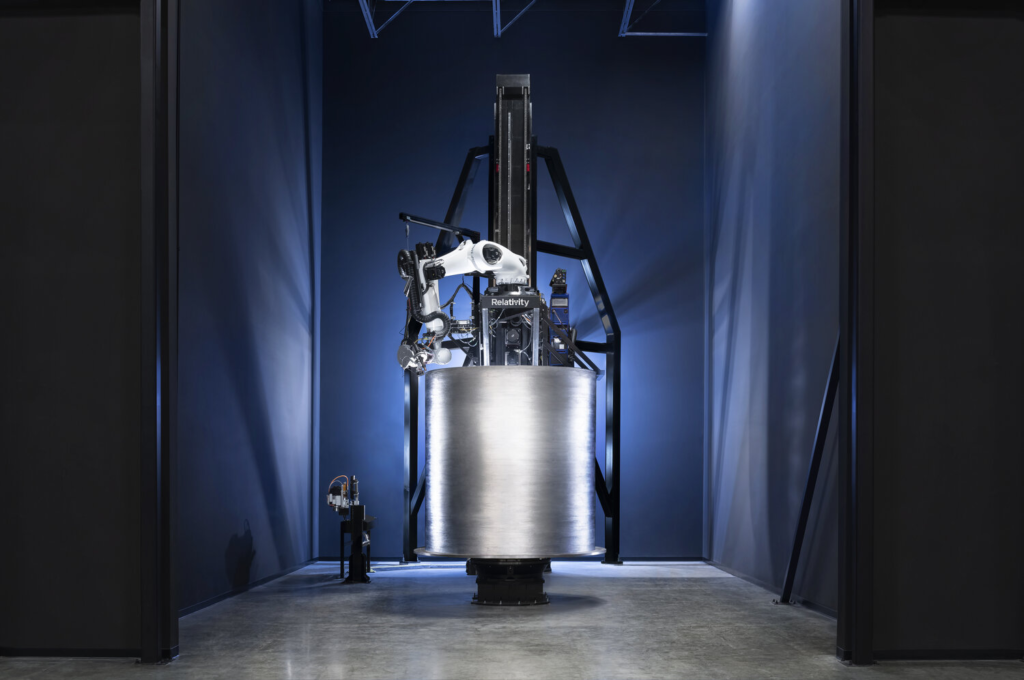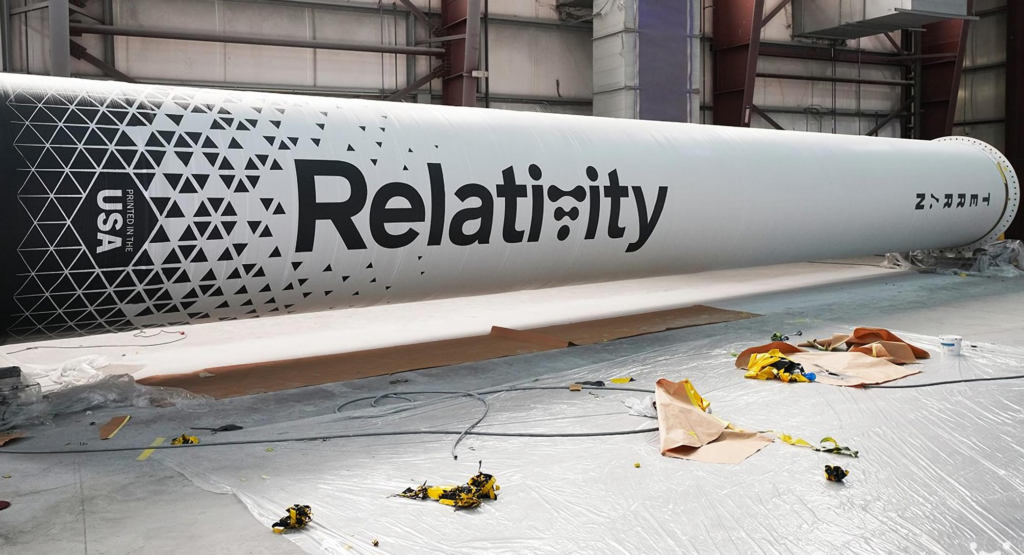
Relativity Continues To Make Progress On Terran R & Prep For Terran 1’s Launch
Relativity Space has been working extremely fast as they continue to try and make progress on a few different large projects. Between Terran R’s future facilities, testing, Terran 1’s first launch, and much more, the company currently has a lot on its plate. Not to mention the fact that they are trying to do practically all of this using a completely unique manufacturing process.
In the last few days, Relativity released more information on its Terran R engine testing, a crucial component of the future launch vehicle expected to be fully reusable. This comes in addition to more details regarding the new Terran R printer, and facilities for the rocket. Terran 1’s first launch is also right around the corner with only a few tests remaining before it will be ready.
Relativity Space has proved they are a determined company with extremely ambitious ideas. Thanks to some funding and promising test results for both rockets, they plan to take the 3D printing process to another level. Here I will go more in-depth into the recent Aeon R engine tests, additional details about Terran R’s new printer, the first launch of Terran 1, and more.
Terran R Engine Test & Printer

Following the same theme from Relativity over the past couple of weeks, they have continued to release more information on Terran R and its components. Just three days ago on the fourth, they tweeted saying, “Today, we stepped into hotfire ops for our 1st Aeon R GG drive circuit. Got through low-power hotfire attempts with no damage and captured great data to inform future full power tests!” This included an image of engine firing from the company’s test stand. This builds on engine testing progress that was announced early last month. In this case, CEO of Relativity Tim Ellis tweeted mentioning, “New Aeon R hardware milestone: first successful test of a subscale (approx 50k lb thrust) injector + calorimeter. Much higher power density and efficiency architecture. At full this article will be about 2x the thrust of Aeon 1 (at subscale; full is 250k lbf). Major step!”
Relativity’s engines, Aeon 1, Aeon R, and Aeon Vac, are 3D-printed, with the goal of enhancing mission reliability by reducing part count in engine combustion chambers, igniters, turbopumps, reaction control thrusters, and vehicle pressurization systems. All Aeon engines including Aeon R, use propellants of the future, liquid oxygen + liquid natural gas, which are not only one of the best for rocket propulsion, but also the easiest to eventually make on Mars. To date, Aeon has completed 500+ test fires. Terran R will utilize 7 Aeon R engines on the first stage and a single Aeon Vac on the second stage. With reusability in mind, Relativity is working hard to create an engine capable of providing the necessary performance to safely land the stages but also ensure a realistic refurbishment process. As of right now, the launch vehicle is expected to be capable of lifting 20,000 kilograms into low earth orbit, with launches starting in 2024. In reality, it will likely be closer to 2025 by the time this launch vehicle begins lifting off.
However, the recent update regarding its new 3D printer is a good sign. Specifically, just a few weeks ago, Relativity unveiled the latest iteration of its first-of-its-kind proprietary manufacturing platform, Stargate 4th Generation metal 3D printers. Not long ago, Scott Van, SVP of Software Engineering pointed out, “Iteration empowers innovation not only in our rocket design, but also in our own Stargate printers. In its short history, Relativity has made great strides in evolving its core 3D printing technology, but Stargate 4th Generation printers are our most innovative leap yet. We’re fundamentally changing the way our factories are designed and operating, and by flipping the script and going horizontal, we’re radically increasing our capacity for scale. Being a software-driven manufacturing company allows us to achieve unique product features, such as integrated pad-ups and domes, with radical flexibility.”
The majority of Terran R components will be printed inside Relativity’s new 1MM+ square foot headquarters in Long Beach, named The Wormhole. Aeon R engines, for Terran R, will continue to be produced at the company’s other Long Beach factory, The Portal. The Wormhole, a former Boeing C-17 manufacturing plant, was secured by Relativity to be its new headquarters in 2021. Currently 33% operational, the factory has several Stargate 4th Generation printers online with more than a dozen printers planned to be producing Terran R components in the coming months. At the full capacity forecasted run rate, each Stargate 4th Generation printer is capable of producing 4 Terran R rockets per year. The remainder of The Wormhole will continue to be built out in phases, bringing more printers online and moving more teams into the company’s headquarters as production for Terran R scales. In the near future, we can expect to watch Relativity continue to ramp up production and testing of this next generation launch vehicle.
First Launch of Terran 1

While Terran R has been making some significant progress in the last few weeks, Relativity has not said much regarding Terran 1. As of right now, Relativity is still scheduled for its first launch of Terran 1, called “GLHF” (Good Luck, Have Fun), from Launch Complex 16 (LC-16) in Cape Canaveral in 2022. This means it’s possible within the next two months we see Terran 1 lift off.
One of the most recent updates on Terran 1’s first launch came just over a month ago in early October. Specifically, on October 3rd, Relativity tweeted highlighting, “Who doesn’t start their week with a new to do list? Integration, Static fire, Make history.” In addition, Tim Ellis commented saying, “It’s time to LAUNCH!! Stoked to get Terran 1 into final integration ahead of launch, and massively proud of the team and their hustle. Our mindset @RelativitySpace is always around setting ambitious goals and taking smart risks. We’re not about to stop doing either.” Based on these updates and the rocket’s timeframe, its very possible that within the next few weeks, we get an update from the company on final integration, testing, and then a launch date.
It’s important to point out that the launch of this rocket is the first orbital attempt by Relativity and will not include a customer payload. As a two-stage, 110ft. tall, 7.5 ft. wide, expendable rocket, Terran 1 is the largest 3D printed object to exist and to attempt orbital flight. Working towards its goal of being 95% 3D printed, Relativity’s first Terran 1 vehicle is 85% 3D printed by mass. Terran 1 has nine Aeon engines on its first stage, and one Aeon Vac on its second stage. Like its structure, all Relativity engines are entirely 3D printed, and use liquid oxygen (LOX) and liquid natural gas (LNG), which are not only the best for rocket propulsion, but also for reusability, and the easiest to eventually transition to methane on Mars. As one of the few LOX/LNG fueled rockets in the industry, Terran 1 is racing to be the first LOX/LNG rocket to fly.
This first launch is a very big deal not only because the Terran 1 design will be put to the test, but also the capability and feasibility of 3D printing rockets. Relativity’s proprietary Factory of the Future centers on Stargate, the world’s largest metal 3D printers, that create Terran 1 from raw material to flight in 60 days. Relativity’s Stargate printers’ patented technology enables an entirely new value chain and innovative structural designs that make Terran 1 and Terran R possible. By developing its Factory of the Future and rockets together, Relativity accelerates its ability to improve design, production, quality, and speed.
Relativity highlights that for over half a century, aerospace manufacturing has relied on large factories, fixed tooling, complex supply chains, and extensive manual labor to build costly rockets comprised of 100,000+ parts in 2 years or longer. In order to accelerate innovation in the industry, Relativity built its Factory of the Future, the first aerospace platform to automate rocket manufacturing, vertically integrating intelligent robotics, software, and data-driven 3D printing technology. Incorporating Stargate, the world’s largest metal 3D printer with AI-driven controls, its Factory of the Future works to continuously optimize production, resulting in greatly compounded quality and time improvements, lower costs, and product designs previously not possible. In the grand scheme of things, Relativity is an application-layer 3D printing company that is starting with rockets, and will extend its Factory of the Future to all of aerospace.
This first test if successful would prove that this manufacturing approach and hardware are realistic and can save both time and money if done correctly. It could also be a positive sign for Terran R and provide Relativity with additional information that they will apply to the fully reusable launch vehicle. This being said, launching a rocket and reaching orbit is an immensely difficult task that few companies and agencies around the world have done. Not to mention that the first ever launch is rarely successful when looking back at even some of the most valuable rocket companies today.
Conclusion
Relativity Space is continuing to work on Terran R and is only a few months away from the first launch of Terran 1. Between work on the Aeon R engines, new 4th generation 3D printers, and the final tests for Terran 1, the company is extremely busy. We will have to wait and see how it progresses and the impact it has on the space industry.
